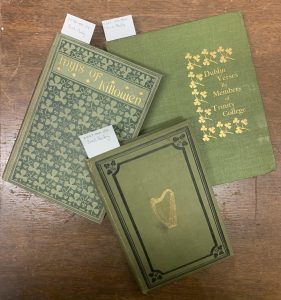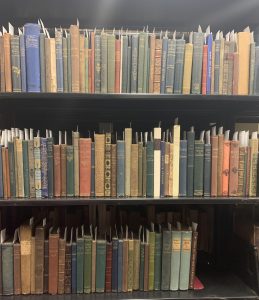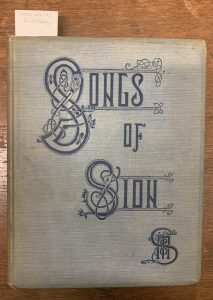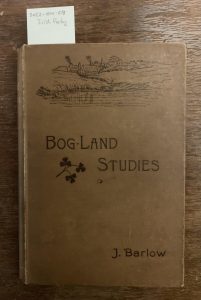In Special Collections, we’ve dressed in our grandest greens to celebrate St. Patrick’s Day. In that spirit, we wanted to take a moment to highlight some books in our collection which are a lot more prepared than us to celebrate the Irish saint’s day, such as these books from our Nineteenth-Century Irish Poetry collection, housed in Rare Books. But how do such recognizably “Irish” bindings come about?

Ireland has long held an odd place amongst the British Isles, as something that is separate and yet (perhaps unwilling) a part of it. Even from its early days of recorded history, Ireland is granted stories and qualities that, while not all necessarily bad, render a place of magic and strangeness, other-ing it from its “more civilized” English neighbor. Bede writes on Ireland’s unnaturally healthy air, of which one breath can kill any snake. Gerald of Wales refutes the superior air, and also peoples the land with werewolves. Later writers, such as William Spencer, were attracted to the rugged wildness of Ireland, even as they opposed its independence. This does not even touch on the folklore traditions of changelings and good folk which carried well into the nineteenth century, and which Ireland is still famous for today.

Because of English efforts to “civilize” what they saw as a barbarous land and people, Ireland has had to cling hard to its culture, its history, and its traditions. With the Celtic revival movement, beginning in the nineteenth century, came a new appreciation for Irish art and poetry. Irish artists dove into traditional myth and folklore, and pulled from traditional Irish art to establish ‘Celtic motifs.’ The Irish literary revival encouraged writers to bring back styles that mirrored the old traditions and Irish poetry as its own distinct art form flourished.
Which brings us back to the collection of nineteenth-century Irish poetry donated to Catholic University’s Rare Books department in 2022, by Frank and John Mulderig. While much of the poetry follows these revival themes of old myths and meter, one hardly needs to open the pages to feel the movement’s effects. Every book in this collection comes in a binding that is either original or, in a few rare cases of rebinding, contemporary to the book’s publication.

These bindings draw from a wide scope of Irish art and history to make a collection of visuals which take inspiration from a variety of sources in Irish history. For instance, this book of poetry, entitled Songs of Sion, draws from what is likely the most famous and influential illuminated manuscript in all of Ireland, the Book of Kells. You can see the manuscript’s influence in the capital S’ styled after the illuminated capitals of the Book of Kells, which were often made to look like animals, and in the Celtic knots used throughout.

And then, there are the simple scenes of a quiet and long lasting way of life, such as is shown on the cover of Bog Land Studies. The cover presents the Irish countryside, with its peat roofed houses, and cozy puffs of chimney smoke. There are the woods behind the houses and then, stretched out in front of the scene is a quiet and unassuming bog, in which ancient secrets could lie quietly hidden. (The Celtic revival movement also brought about an interest in Irish archeology. It was during this period in the nineteenth century that people began to realize that the strange bodies sometimes found preserved in their peat bogs might be from a much older time.)
When thinking about a rare book, it’s important to remember that one must consider more than just the text. Books are artifacts in their own right, and while the inner pages may showcase the breath of stories and experience from Irish citizens and expats, as they explore their land, history, and personal experiences, the bindings on these books tell their own stories.
As of the publication date of this blog, the Irish Poetry collection is being cataloged. Inquiries about the collection can be referred to: lib-rarebooks@cua.edu
